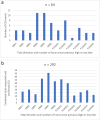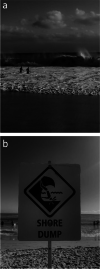Cervical spine injuries occurring at the beach: epidemiology, mechanism of injury and risk factors
- PMID: 35869457
- PMCID: PMC9306180
- DOI: 10.1186/s12889-022-13810-9
Cervical spine injuries occurring at the beach: epidemiology, mechanism of injury and risk factors
Abstract
Objective: Surf zone injuries include cervical spine injuries (CSI). Risk factors for CSI have not been extensively investigated. The objective was to examine risk factors associated with diagnosed CSI that occurred in a beach setting.
Methods: This retrospective case series used manually linked data from Sunshine Coast Hospital and Health Service Emergency Departments, Queensland Ambulance Service, Surf Life Saving Queensland (SLSQ), and Bureau of Meteorology data from 01/01/2015-21/04/2021. Variables included victim demographics, mechanism of injury, scene information, and patient course.
Results: Seventy-nine of the 574 (13.8%) confirmed CSI occurred at the beach. Local residents and visitors were injured equally. Females represented a minority (12.7%) of those diagnosed with CSI but were a higher proportion of suspected spinal incidents reported to SLSQ (45%). Surfers were more likely to be injured through shallow water diving than swimmers (27.6% vs 2.2%). Females were more likely to be injured by shallow water diving than males (30.0% vs 8.7%). Visitors were more likely to be injured swimming and local residents surfing (68.2% vs 77.8% respectively). CSI occurred most commonly (40.0%) with a below average ocean wave height (0.75-1.25 m) and were most likely (45.3%) to occur in the second half of the outgoing tide. One beach had a statistically significant greater incidence of spinal incidents (OR 3.9, 95% CI: 2.1-7.2) and of CSI (OR 10.7, 95% CI: 1.5-79.5).
Conclusions: Risk factors for CSI at the beach include male sex, smaller wave height and an outgoing tide. Shallow water diving among surfers and females should be addressed urgently.
Keywords: Cervical spine injury; Risk of drowning; Shallow water diving.
© 2022. The Author(s).
Conflict of interest statement
There are no competing interests.
Figures



Similar articles
-
Cervical spine immobilisation is only required in drowning patients at high risk of axial loading of the spine.Emerg Med Australas. 2023 Feb;35(1):18-24. doi: 10.1111/1742-6723.14036. Epub 2022 Jul 25. Emerg Med Australas. 2023. PMID: 35878883 Free PMC article.
-
Shifting Trends in the Epidemiology of Cervical Spine Injuries: An Analysis of 11,822 Patients from the National Electronic Injury Surveillance System over Two Decades.J Neurotrauma. 2024 Sep;41(17-18):2158-2167. doi: 10.1089/neu.2024.0194. Epub 2024 Aug 2. J Neurotrauma. 2024. PMID: 39041612
-
Beach Breaking Waves and Related Cervical Spine Injuries: A Level One Trauma Center Experience and Systematic Review.World Neurosurg. 2022 Apr;160:e471-e480. doi: 10.1016/j.wneu.2022.01.055. Epub 2022 Jan 21. World Neurosurg. 2022. PMID: 35074543
-
A prospective multicenter study of cervical spine injury in children.Pediatrics. 2001 Aug;108(2):E20. doi: 10.1542/peds.108.2.e20. Pediatrics. 2001. PMID: 11483830
-
Imaging of pediatric cervical spine trauma.Emerg Radiol. 2021 Feb;28(1):127-141. doi: 10.1007/s10140-020-01813-1. Epub 2020 Jun 30. Emerg Radiol. 2021. PMID: 32601894 Review.
Cited by
-
Overview of Cervical Spine Injuries Caused by Diving Into Shallow Water on Jeju Island: A 9-Year Retrospective Study in a Regional Trauma Center.Korean J Neurotrauma. 2025 Apr 25;21(2):79-92. doi: 10.13004/kjnt.2025.21.e16. eCollection 2025 Apr. Korean J Neurotrauma. 2025. PMID: 40353275 Free PMC article.
-
Spinal fractures associated with aquatic accidents.J Orthop. 2025 May 13;66:165-172. doi: 10.1016/j.jor.2025.05.013. eCollection 2025 Aug. J Orthop. 2025. PMID: 40486530
References
-
- Daw SL, Cooney J, Elis N, Strassioto L. National Coastal Safety Report 2020. Sydney: Surf Life Saving Australia; 2020.
-
- Short A, Brander R. Beach Hazard and Risk Assessment. In: Bierens JJLM, editor. Drowning: Prevention, Rescue, Treatment. 2. Berlin: Springer-Verlag; 2014.
-
- Surf Life Saving Queensland. Coastal Safety Report 2021. South Brisbane: Surf Life Saving Queensland; 2021. p. 11.
-
- Castelle B, Brander R, Tellier E, Simonnet B, Scott T, McCarroll J, et al. Surf zone hazards and injuries on beaches in SW France. Nat Hazards. 2018;93(3):1317–1335. doi: 10.1007/s11069-018-3354-4. - DOI
-
- Puleo JA, Hutschenreuter K, Cowan P, Carey W, Arford-Granholm M, McKenna KK. Delaware surf zone injuries and associated environmental conditions. Nat Hazards. 2016;81(2):845–867. doi: 10.1007/s11069-015-2108-9. - DOI
Publication types
MeSH terms
Substances
LinkOut - more resources
Full Text Sources
Medical

